List of buildings and structures in Cusco
This is a list of notable buildings in the city of Cusco, Peru. The city of Cusco is a World Heritage Site by UNESCO. The list is ordered by the groundbreaking date of each building.
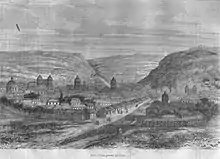
View of Cusco in 1887.
Pre-Columbian buildings
They are listed with its names in the modern Quechua orthography.
| Name | Image | Built | Civilization who built it | Source | Location | ID |
|---|---|---|---|---|---|---|
| Much of the Colonial constructions used the city's Inca constructions as a base. |  | Most in the 15th century. The pre-columbian re-design of the city (through a remodeling) is the work of Sapa Inca Pachakutiq | Inca architecture | [1] | Cusco | |
| Saqsaywaman | 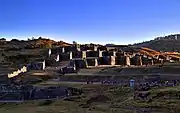 | 1100-early 16th century | Killke culture, Inca architecture | [2][3][4] | Two kilometers north of Cusco | |
| Remains of the Qurikancha (temple of Inti -god Sun-) | 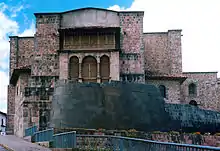 (below and inside the Convent of Santo Domingo) | It was started to be built by the Ayarmacas (around 13th-14th centuries), remodelled by Sapa Inca Pachakutiq (15th century) | Inca architecture | [5] | Calle Arraniyoq | CUS-046 |
| Base of the Muyuq Marka Tower (actually a temple of Inti -god Sun-) | 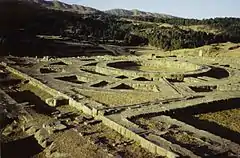 | It is part of the set of Saqsaywaman (idem) | Inca architecture | [6][7] | Two kilometers north of Cusco |
Colonial buildings
Churches
The list is incomplete.
| Name | Image | Built | Architectural style | Architect(s) | Belonged to the religious order | Source | Location | ID |
|---|---|---|---|---|---|---|---|---|
| Templo del Triunfo | 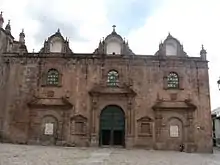 | 1539-1664 | Renaissance | [8] | Plaza de Armas (city's main square) | CUS-047 | ||
| Church of San Blas | _(Cuzco)_(4578175980).jpg.webp) | 1544-1563 (its interior decor was built in the late 17th century) | (its extensively carved cedar pulpit is Churrigueresque) | [9][10] | Plazoleta de San Blas | CUS-037 | ||
| Ruins of the Convent of San Agustín |  | 1556-1645 | Order of Saint Augustine | [11][12] | Corner of Ruinas, San Agustín and Santa Mónica streets. No. 140, Mz. 15. | CUS-079 | ||
| Cusco Cathedral | 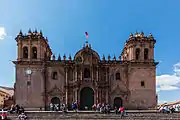 | 1560-1654 | Renaissance (exterior), Plateresque Gothic, Baroque (interior) | Spanish Juan Miguel de Veramendi, criollo Juan Correa, Spanish Miguel Gutiérrez Sencio | [8] | Plaza de Armas (city's main square) | CUS-028 | |
| Church of San Sebastián | 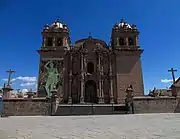 | 1572-1799 | Baroque (in 2016 a fire inside destroyed the altar, many sculptures, exceptional large paintings and diptychs, but not the most, which was saved) | [13][14] | San Sebastián District | CUS-088 | ||
| Church of la Compañía de Jesús |  | 1576-1668 | Andean Baroque | Flemish Jean-Baptiste Gilles, Diego Martínez de Oviedo (criollo) | Society of Jesus | [15][16] | Plaza de Armas (city's main square) | CUS-030 |
| Monastery of Santa Clara |  | 1603-1650 | Renaissance, Baroque | A Greek friar, his hispanized name was "Manuel Pablo" | Franciscan Poor Clare Missionary Sisters of the Blessed Sacrament | [17][18] | Calle Santa Clara | CUS-043 |
| Church of San Francisco de Asís | 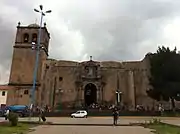 | 1645-1652 | Romanesque, Plateresque (most of its interior is original although there are also some interior reconstructed areas). | Franciscans | [19][8][20] | Plaza de San Francisco | CUS-039 | |
| Monastery of Santa Catalina de Siena |  | 1651-1669 | Dominican Nuns Order | [21] | Calle Santa Catalina Angosta | CUS-042 | ||
| Basilica of La Merced | .jpg.webp) | 1651-1696 | Baroque, Renaissance (exterior), Baroque, Neoclassical (interior) | Order of the Blessed Virgin Mary of Mercy | [22][23] | Plazoleta Espinar, Calle Mantas 121 | CUS-033 | |
| Church of San Cristóbal | 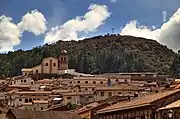 | second half of 17th century | Mannerism | Marcos Uscamayta (an inca indigenous) | [24] | Calle Don Bosco at the west end of the Plaza del Colcampata on the Sacsayhuamán Hill | CUS-038 | |
| Monastery of San José y Santa Teresa |  | 1673-1676 | Baroque | Diego Martínez de Oviedo (criollo) | Discalced Carmelites | [8][25] | Two blocks from the Plaza de Armas at the intersection of Siete Cuartones and Saphy streets. | CUS-044 |
| Church and Seminary of Saint Anthony the Abbot | 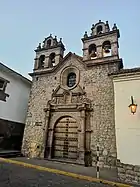 | 1678-1692 (church) | Andean Baroque | [26][27] | Plazoleta de las Nazarenas | CUS-036 | ||
| Convent of Santo Domingo | .jpg.webp) | 1680-early 18th century | Baroque | several | Dominican Order | [8] | Calle Arraniyoq | CUS-046 |
| Church of la Almudena |  | 1683-1689 | Baroque | Juan Tomás Tuyru Túpac (an inca indigenous) | Order of the Brothers of Bethlehem | [29] | Plazoleta de Almudena, Santiago | CUS-027 |
| Church of San Pedro | _(4578184162).jpg.webp) | 1688-1699 | Andean Baroque, Renaissance | Juan Tomas Tuyro Túpac (an inca indigenous) | [30][8] | Calle Cascaparo | CUS-040 | |
| Templo de la Sagrada Familia |  | 1723-1735 | Renaissance | Spanish Francisco Becerra | [31] | CUS-031 | ||
| Central Chapel of Santo Roma |  | 1802 | Baroque (It is today used as the La Almudena cemetery room incinerator.) | Bishop Bartolomé María de las Heras | [32][33] | La Almudena General Cemetery | CUS-023 |
Other buildings
| Name | Image | Built | Architectural style | Architect(s) | Source | Location | ID |
|---|---|---|---|---|---|---|---|
| Balconies of Cusco | 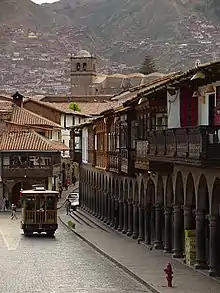 | 16th-19th centuries | Mudéjar, Baroque | [34] | Cusco | ||
| House of Inca Garcilaso de la Vega (also today it is the Museo Histórico Regional del Cusco) |  | late 16th century | Andalusian architecture, Colonial Peruvian architecture, Inca architecture (the first floor of the front facade was remodelled in 1953 adding the arcades) | [35][36] | Calle Heladeros corner with calle Garcilaso | CUS-061 | |
| Archbishop's Palace of Cusco (now it is the Museo de Arte Religioso) | 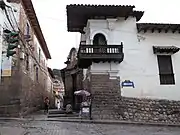 | completed in the second half of the 17th century (and it was strongly decorated in the mid-20th century with ornates from other colonial buildings when the palace became the archbishop's palace) | Colonial Peruvian architecture, Inca architecture, Pre-Inca architecture | [37] | Calle Hatun Rumiyoq | CUS-053 | |
| Hospital of la Almudena | 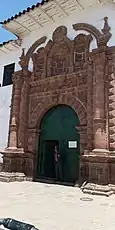 | 1689-late 18th century | Baroque (It was managed by the Order of the Brothers of Bethlehem) | [37] | Plazoleta de la Almudena, Santiago District | CUS-027 | |
| Hospital and Convent of San Juan de Dios |  | 1615-1617 | Renaissance (It was managed by the Brothers Hospitallers of Saint John of God) | [38] | Calle Teatro, Calle Nueva | CUS-052 |
Republican buildings (post-colonial)
| Name | Image | Built | Architectural style | Architect(s) | Source | Location | ID |
|---|---|---|---|---|---|---|---|
| La Almudena General Cemetery |  (the entrance is the left building) | 1846-1850 | Baroque, Neoclassical | [39][32] | Plazoleta de la Almudena, Santiago | CUS-023 |
References
- "City of Cuzco". UNESCO World Heritage website.
- Allegra Stratton (14 March 2008). "Archaeologists discover ruins of Inca temple in Peru".
- "Pre-Inca temple uncovered in Peru". CNN. 17 March 2008.
- "Pre-Inca' temple found in Peru". BBC. 14 March 2008.
- Pedro Sarmiento de Gamboa (2015). History of the Incas (PDF). Lexington. ISBN 9781463688653.
- Inca Garcilaso de la Vega (Comentarios Reales de los Incas) (1609). Comentarios Reales de los Incas (PDF). Pedro Crasbeeck. pp. 67 of the original book.
- Williamson, Ray A. (1981). Archaeoastronomy in the Americas. Ballena Press. p. 326. ISBN 978-0-87919-094-1. Retrieved 16 July 2012.
- Víctor Anglés Vargas (1983). Historia del Cusco. II. Lima: Industrial Gráfica. pp. 84, 102, 435–443, 492, 549, 759–768.
- Paula Newton (2011). Cusco, Machu Picchu and Sacred Valley (First ed.). Viva Publishing Network. ISBN 978-0-9825585-2-2.
- "Templo De San Blas". Ministry of Foreign Trade and Tourism (Peru).
- Paula Newton (2011). Cusco, Machu Picchu and Sacred Valley (First ed.). Viva Publishing Network. ISBN 978-0-9825585-2-2.
- "Templo De San Blas". Ministry of Foreign Trade and Tourism (Peru).
- "La iglesia de San Sebastián y las obras de arte que guardaba". La República. 16 September 2016.
- "Un total de 24 lienzos se perdieron en incendio de templo San Sebastián". Andina (news agency). 23 September 2016.
- Fred S. Kleiner (2010). Gardner's Art through the Ages: The Western Perspective. 2 (Fifteen ed.). Boston: Cengage. p. 608. ISBN 978-1-305-64505-9.
- Luisa Elena Alcalá. De historias globales y locales: Una aproximación a la historiografía de la arquitectura de los jesuítas en Hispanoamérica (PDF). Autonomous University of Madrid. p. 479.
- "Iglesia y Convento de Santa Clara". cuscoinmortal.com (in Spanish).
- Kathryn Burns (1998). "Gender and the Politics of Mestizaje: The Convent of Santa Clara in Cuzco, Peru". The Hispanic American Historical Review. Duke University Press. 78 (1): 5–44. doi:10.1215/00182168-78.1.005. JSTOR 2517377.
- "La iglesia de San Francisco del Cuzco". blog.pucp.edu.pe (in Spanish). 5 October 2009.
- "Turismo en Iglesia y Convento de San Francisco (Iglesias)". turismoi.pe.
- Deysi Navarro Linares (2012). "El Convento de Santa Clara y la mujer mestiza cuzqueña: 1560-1600" (PDF). National University of Saint Anthony the Abbot in Cuzco. Cite journal requires
|journal=(help) - "Basilica of La Merced website". Basilica of La Merced website.
- Ephraim George Squier (1877). Peru; incidents of travel and exploration in the land of the Incas. London: MacMillan and Co. p. 454. ISBN 1296850730.
- Víctor Angles Vargas (1988). Historia del Cusco Incaico. I. Lima: Talleres de Industrial Gráfica S.A. pp. 100–105.
- "10. Templo de Santa Teresa". Spanish Agency for International Development Cooperation (in Spanish).
- "Iglesia y Seminario de San Antonio Abad". sanantoniocusco.blogspot.com (in Spanish).
- "Turismo en Antigua Iglesia y Seminario de San Antonio Abad". turismoi.pe (in Spanish).
- Ramón Gutiérrez (1987). "Arquitectura virreynal en Cuzco y su región". National University of Saint Anthony the Abbot in Cuzco.
- "8. Templo de San Pedro". Spanish Agency for International Development Cooperation (in Spanish).
- "7.3. Templo de la Sagrada Familia". Spanish Agency for International Development Cooperation (in Spanish).
- Manuel Vela Tudela Wither (13 April 2015). "El cementerio más antiguo de Cuzco". El País.
- Adelayda Letona (9 November 2012). "El Cementerio de la Almudena: un recinto mortuorio con historia". Grupo RPP.
- Adelayda Letona (August 17, 2012), "Los balcones de estilo árabe en la ciudad del Cusco", RPP TV news
- "Museo Histórico Regional, Casa del Inca Garcilaso de la Vega". Biblioteca Virtual Miguel de Cervantes.
- Lippincott's monthly magazine, a popular journal of general literature, 10, Philadelphia: J. B. Lippincott & Co., 1872, p. 610
- Mario R. Castillo Centeno; Elizabeth Kuon Arce (2017). Cusco: Ciudad, Valle, Departamento. Guía de Arquitectura y Paisaje (PDF). Seville, Cusco: Regional Government of Andalusia. pp. 196, 365. ISBN 978-84-8095-592-8.
- Diego de Esquivel y Navia (1980), Noticias cronológicas de la gran ciudad del Cuzco, Fundación Augusto N. Wiese
- "30. Plazoleta de la Almudena". Spanish Agency for International Development Cooperation (in Spanish).
This article is issued from Wikipedia. The text is licensed under Creative Commons - Attribution - Sharealike. Additional terms may apply for the media files.